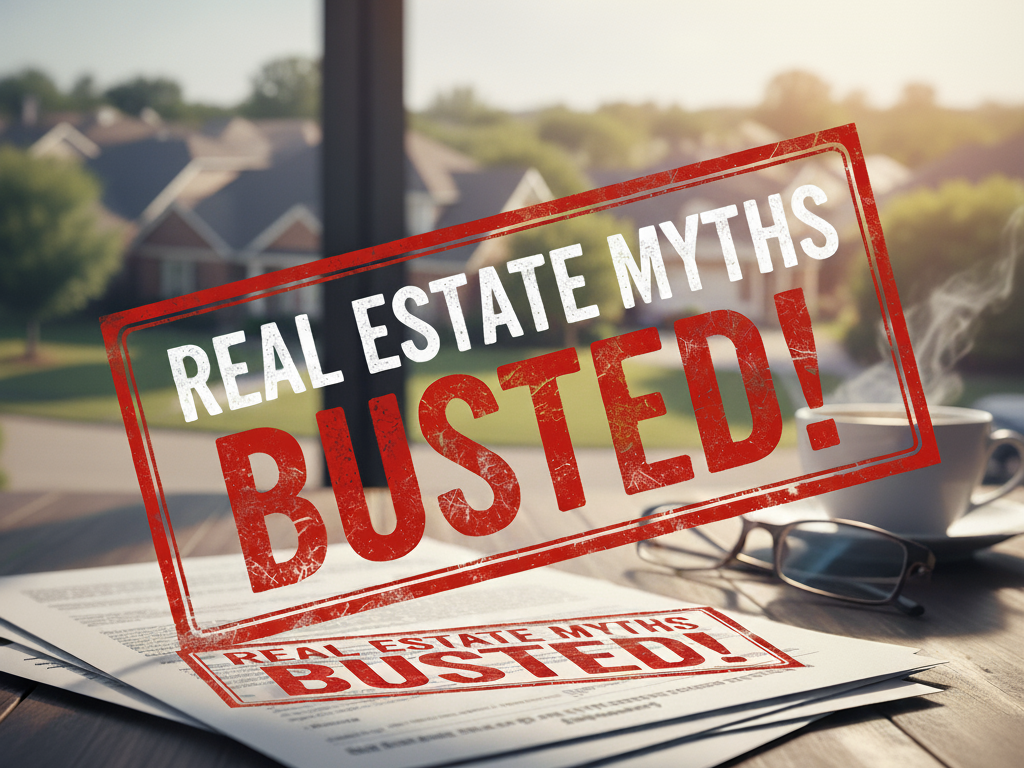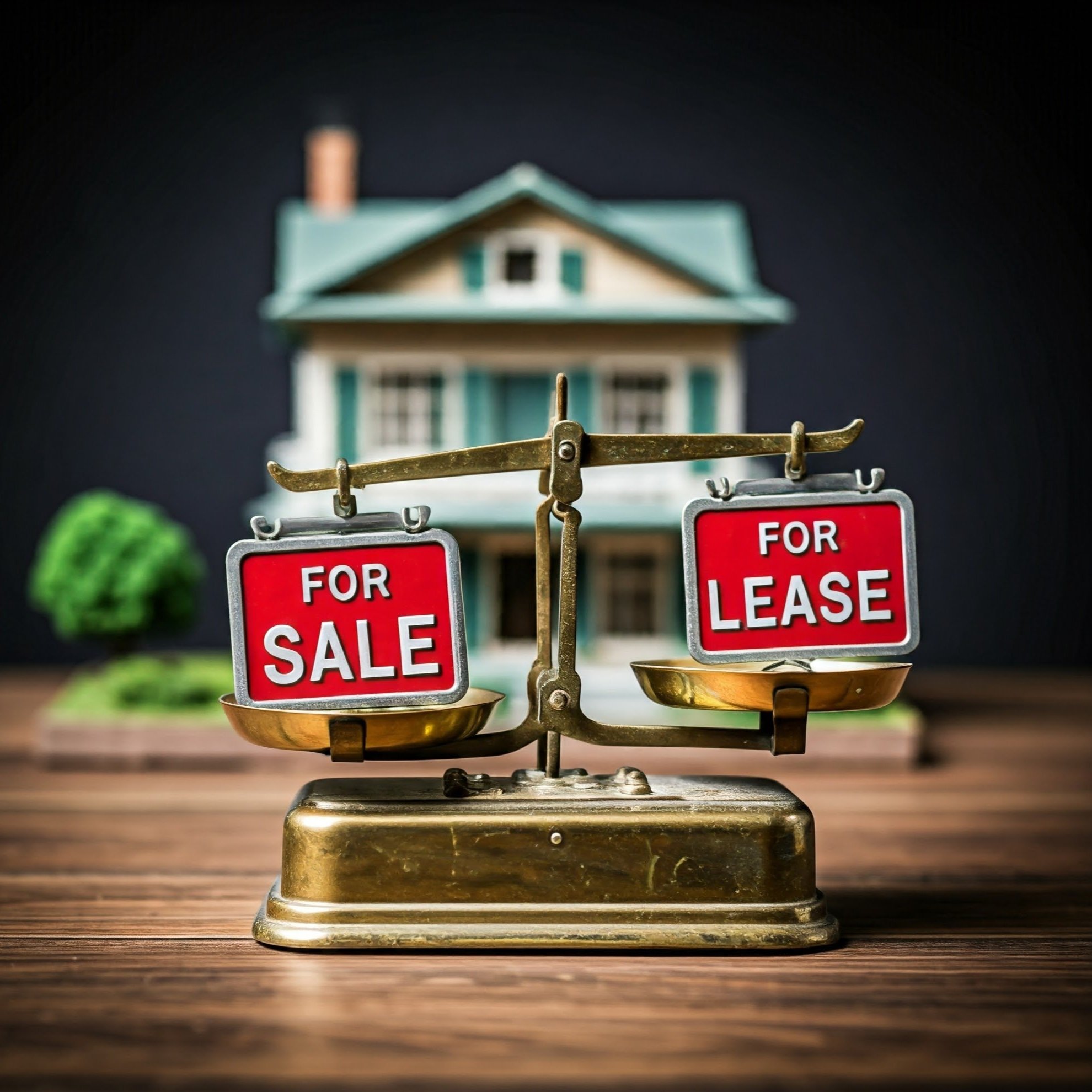Smart Insurance Strategies for Rental Property Investors: A Complete Guide
Rental properties provide significant financial benefits to investors — I’ve written about this extensively on this blog, both in general terms and by transparently providing all the actual results from my portfolio of 25 rental properties.
But as with any investment, there are risks: choosing the wrong market or buying the wrong properties can be very costly (hiring a coach like me can help you avoid those risks); placing bad tenants or performing shoddy maintenance work can also sink your investment over time, which is why I strongly recommend professional property management. Clearly, risk mitigation is an important part of long-term success with rental properties.
But there’s also the risk of physical damage to the house itself from fire, severe weather, and other hazards. An insurance policy is the financial safety net that protects against these threats and safeguards your assets. But what specific type of insurance do you need? What types of coverages should it have, and how much? How do you find a good provider? And how do you deal with your insurance provider in the event of a claim?
In this article, I’ll touch on all of those points and more — and as I always like to do, I’ll include specific examples and stories from my experience with my own portfolio and from working with over 100 private coaching clients.
Ok, let’s get into it!
I. Understanding the Basics of Rental Property Insurance
Insurance for rental properties (often called landlord insurance) differs a bit from standard homeowners insurance, both in terms of coverage and purpose. While certain elements will be found in both types of policies, such as property coverage and liability protections, there are important differences. For example, homeowners insurance typically includes coverage for personal belongings inside the property, but landlord insurance does not because you won’t have any personal belongings there. (Tenants can protect their belongings with renters insurance, which is required by some leases and/or property managers.)
What Does Rental Property Insurance Typically Cover?
While policies vary by provider, there are two components of landlord insurance that will be present on ALL policies:
Property Coverage
Also sometimes called dwelling coverage or building coverage, this covers the physical structure of the property against risks like:
Fire and smoke
Storm damage
Vandalism and theft
Burst pipes
Explosions
Liability Protection
If a tenant or visitor is injured on your property and holds you responsible, this coverage helps pay for:
Legal defense costs
Medical expenses
Settlements or court judgments
For example, if a tenant slips on an icy sidewalk that you failed to salt and sues for medical bills, your liability protection would come into play.
Optional Coverages & Add-Ons
But that’s not necessarily all. There are several other types of coverage that are frequently offered as optional add-ons:
Loss of Rental Income
If your rental becomes uninhabitable due to a covered loss, this coverage replaces lost rental income during the repair period. This is a very common add-on for landlord insurance — in fact, it’s mandatory in some policies.
For example: if there is a house fire bad enough that your tenant has to move out, this coverage would pay you the lost rent (typically up to a maximum number of months, i.e. six months) until the house is fixed up and your next tenant is in place.
Important caveat: This only applies to income lost from covered events, not vacancies, evictions, or non-payment of rent. But there is a newer type of insurance that DOES cover this, called tenant default insurance (see below).
Ordinance and Law
This covers the extra costs of bringing your property up to current building codes during reconstruction. This might be especially important for older homes, depending on how strict local ordinances are in your market.
Sewer & Backup
While most policies will cover water damage from burst pipes, some will exclude water damage that results from sewer blockages and backups. This additional coverage option would add that protection to your policy.
Tenant Default Coverage
Also called “rent guarantee insurance”, this reimburses you for missed rent payments due to non-paying tenants. This is not available from all providers, and (as of now) is usually purchased as separate policy from a provider that specializes in tenant default insurance.
What is NOT Covered By Rental Property Insurance?
Flood
Just as with your standard homeowners insurance, rental property policies don’t cover flood damage (e.g., from hurricanes or heavy rain). You'll need a separate FEMA-backed flood insurance policy or a private alternative. Better yet, though, is to avoid properties that have any flood risk at all, which I’ll talk about a bit later in this article.
Earthquake
As with flood, earthquake damage is not part of standard insurance policies. So if you own property in earthquake-prone areas, you might want to buy a separate policy for this. Again, though, avoiding markets that could be impacted by earthquakes is probably your best bet.
Tenant Damage
In most cases, damage caused by the tenant — either intentionally or through neglect — are not covered by landlord policies. You can sometimes add a rider to cover tenant damages.
II. Key Insurance Strategies for Rental Property Investors
Now that we’ve covered the basics, I want to provide some more specific guidance on common questions that will arise as you make decisions about insurance coverage for your properties. This should help you navigate your options, keep your costs down, and choose coverages that suit your risk tolerance.
How Much Property Coverage Should I Get?
This is the most important question to answer about your insurance policy, and the most consequential one when it comes to cost. Why? Because the vast majority of the cost of your insurance policy will be the property coverage — and the more you get, the higher the cost.
My general approach has always been to insure the property for the purchase price. So if I buy a house for $125,000, I want property coverage of $125,000 to fully protect my investment. However, the purchase price can be lower than “Full Replacement Value”, the amount that would be required to rebuild the home in the event of a total loss such as, say, a catastrophic fire. Some providers will recommend (or require) that you insure for full replacement value, which might be $175,000 or more in this example, and that would drive up your property coverage costs significantly.
Other providers will require you to have a minimum amount of property coverage per square foot. These minimums have been a big stumbling block for my policies over the years, as providers have used these minimums (which seem to increase each year) to force me to carry more property coverage than I want to. Therefore, it’s extremely valuable to find an insurance provider who will allow you to freely set your property coverage amount at the level you want.
One more thing about property coverage amounts: over time, it’s prudent to increase your property coverage if the value of the house has increased. That way, the equity you’ve accumulated is fully protected.
How Much Liability Protection Do I Need?
A typical landlord policy will have $500,000 or $1,000,000 of liability protection. My policies have $1M, which I like.
One thing you’ll notice right away about the liability protection in landlord policies is that it’s extremely cheap compared to property coverage. While many investors worry a LOT about liability (slips, falls, and dog bites, oh my!), the low cost of $1M of liability coverage gives away the game: this is not a major risk that insurers often have to pay out against. Why not? Because all involved parties are highly incentivized to settle out of court in the vary rare cases when a suit is brought. (I wrote about this in more detail in my article on LLCs for Rental Properties as part of demonstrating that the liability protections of LLCs are superfluous in 99.9% of cases.)
Particularly if you have a large portfolio, you might consider buying additional liability coverage through an umbrella policy. This coverage would be applicable in the almost unthinkable situation where your liability exceeds the amount of coverage in your individual landlord policies. For example, you could buy an umbrella policy that would provide an additional $1M of liability coverage layered on top of your individual policies, and it would apply to all properties in your portfolio (as well as, potentially, other assets you own such as a primary residence and/or cars.) These policies are also shockingly affordable, so they’re a good choice for investors who need additional piece of mind, but the likelihood that you would ever need or use this additional coverage is extremely low.
What About My Deductible — Low or High?
The deductible is the amount you are responsible for in the event of a claim before your insurance kicks in. For example, if you have a $5,000 deductible and a $15,000 claim, you would pay the first $5,000 and the insurance would pay the additional $10,000.
Most policies will allow you some choice on where to set your deductible: $5,000 is a common deductible, but you might have the option for a lower deductible (i.e. $2,500) or a higher one (i.e. $7,500 or $10,000). The lower deductible policy will cost you slightly more, whereas opting for a higher deductible will save you some money on your premium.
Where to set your deductible is a personal choice based on risk tolerance. I’m personally a proponent of higher-deductible policies, because it saves on insurance costs while still providing adequate financial protection in the case of REALLY bad damage. Plus, filing an insurance claim is something I want to do as infrequently as possible, for two reasons: first, it helps me to maintain a clean “claims profile” which guards against future increases in premiums; and second, it can be an arduous, frustrating process. Since I only want to deal with my insurance company if the financial stakes for me are very high, a high deductible makes the most sense for me — but this might be different for you.
Other Tips and Strategies for Investors
My experience has taught me numerous other lessons about insurance:
Avoid flood risk. Flood insurance is expensive, so it can crush your cash flow. More importantly, though, you really don’t want a flood at your property whether you’re insured or not — and it’s possible to avoid nearly all flood risk by using RiskFactor to assess the flood risk of any individual property before buying it.
Buy homes in safer areas. When considering which markets to invest in, climate and weather risk should be a big part of your thought process. You may want to:
avoid coastal markets with tropical storm risk
avoid markets with severe winters
avoid markets (and individual properties) with wildfire risk
Negotiate your renewals. Providers will frequently try to jack up your costs at renewal time. But you can fight back, especially if you have multiple properties. Negotiate hard for the best rates you can get.
III. How to Choose the Right Insurance Provider
Finding the right insurance provider is just as important as choosing the right type of coverage. Not all insurers are created equal, especially when it comes to policies for rental properties. As a real estate investor, you need a partner who understands the unique risks, responsibilities, and financial goals involved in managing rental assets.
Insurance Broker vs. Direct Quotes
Your first decision will be whether to use an insurance broker. This can be beneficial because a broker has the ability to provide quotes from multiple insurance providers, allowing you to easily compare policies and costs. Using a broker doesn’t cost you anything, because they make their commissions from the insurance companies.
You can also proceed on your own and get quotes directly from insurance providers. The names of the largest providers (i.e. Allstate, State Farm, etc.) are well-known, but many smaller providers will be tougher to find because they sell policies primarily through brokers. Plus, the large, generalist insurers may not fully understand the nuances of rental property ownership, so most investors seek out providers that specialize in or have extensive experience with landlord insurance specifically.
In fact, there are brokerages such as RealProtect that specialize in connecting investors with providers who focus on landlord insurance. Several online brokerages now do the same, such as Obie (my personal favorite), Steadily, and Honeycomb.
One other option worth mentioning: some property managers also have group policies for their owners. In this model, they work with a 3rd-party insurance provider to offer landlord insurance to their owners, serving as a quasi-broker or middleman. The benefits of this model are that annual renewals are handled by the PM at the level of the group policy, giving them much more leverage than you would have as an individual investor. Plus, your PM can help facilitate communications and operational needs with the insurance provider in the event of a claim, which can make the process smoother.
How to Compare Landlord Insurance Quotes
Once you have quotes in hand, you’ll need to compare them and select your policy and provider. It’s tempting to focus only on premium costs, but cheaper isn’t always better. Here are some key questions to ask about each policy?
What is covered vs. not covered?
What’s the deductible for property damage? Liability claims?
Are there separate deductibles for different perils (e.g., hurricane, hail, vandalism)?
Are there separate deductibles for vacant properties?
Is there a cap on rental income reimbursement?
Also be sure you “read the fine print” and understand each policy’s exclusions. You’re looking for things like:
Exclusions for tenant-caused damage or mold
Time limits on loss-of-rent coverage
Clauses about property being vacant or under renovation
Limits for “acts of God,” civil unrest, or ordinance enforcement
If you’re building a portfolio, it’s generally a good idea to keep all your policies with the same provider. The more policies you have, the more leverage you have — both at annual renewal time, and in the event of a claim.
IV. Claims Management for Rental Investors
Insurance is only valuable if it works when you need it most. That’s why understanding the claims process is critical for rental property investors. Managing claims poorly can lead to denied payouts, increased premiums, or even policy cancellation.
Document Everything—Before, During, and After a Claim
Proper documentation is your strongest defense when filing a claim. It’s an unfortunate fact that insurance companies have a strong financial incentive to pay as little as possible, making disputes common — so you want all your ducks in a row when it comes to documentation. Note that if you use professional property management, much of this documentation will come from and/or be managed by your PM.
Before a Claim Occurs:
Perform and record regular inspections (move-in/move-out checklists, annual maintenance walk-throughs)
Photograph all rooms and appliances in their original condition
Keep receipts and invoices for repairs, upgrades, or security system installations
During the Incident:
Take timestamped photos or videos of the damage as soon as it’s discovered
Document the cause (if known), such as a leaking pipe or fallen tree
Keep copies of communications with tenants, especially if they reported the issue
After the Incident:
Save quotes, receipts, and contracts from contractors or emergency services
Log all correspondence with your insurance provider or claims adjuster
Maintain a written timeline of events (e.g., when the damage occurred, when you called the insurer, etc.)
Managing the Claims Process
While each insurance provider has a slightly different system, the general steps are usually the same:
Step 1: Notify Your Insurance Company Promptly
Most policies require you to file a claim within a specific time window, often 24–72 hours after discovering the damage
Delays can result in denial or reduced compensation
Step 2: Mitigate Further Damage
You’re responsible for preventing further harm to the property, such as:
Tarping a damaged roof
Turning off water if there’s a leak
Hiring emergency remediation services
Failure to act can reduce your payout
Step 3: Meet with the Adjuster
The insurance company will send an adjuster to evaluate the damage
Be present during the inspection to explain what happened and point out hidden issues
Provide all documentation and photos to support your claim
Step 4: Get Repair Estimates
You may be required to submit one or more quotes from licensed contractors
Some insurers prefer working with “approved vendors”—ask if this applies
Step 5: Review and Respond to the Payout Offer
Ensure the settlement fully covers the necessary repairs or replacements
If you disagree with the offer, you can negotiate
Know When to File and When Not To
Not every incident warrants filing a claim. In fact, small or frequent claims can increase your premiums or lead to policy non-renewal.
When It Makes Sense to File:
The repair cost significantly exceeds your deductible
The damage is covered by your policy (not an exclusion)
There’s a liability risk (e.g., tenant injury)
When to Consider Paying Out-of-Pocket:
Damage is minor and costs less than (or only slightly more than) your deductible
You’ve already made a claim in the last few years (multiple claims = red flag for insurers)
The event falls into a gray area that might trigger a denial or policy scrutiny
V. Landlord Insurance: A Real-World Case Study
Here is an actual example from my investing career that shows insurance in action. There’s no teacher like experience, so I always like to “make it real” for you by providing some real-life cast studies so you can learn from my experience.
On July 22nd, 2024, I received an unwelcome work notice from my PM: a neighbor’s tree had fallen on one of my properties (Property #6), and it would cost $2,500 to remove the tree. Once the tree was removed, the damage to the house could be fully assessed. (Unfortunately for me, in Memphis, the fact that the tree belonged to my neighbor isn’t material; I’m still responsible for the cleanup and any damage.)
My PM ensured that there was full documentation in place (i.e. notice from the tenant, photos of the damage, and the invoice for the removal of the tree.) The photos tell the story — it wasn’t pretty, either before or after the tree limb was removed:
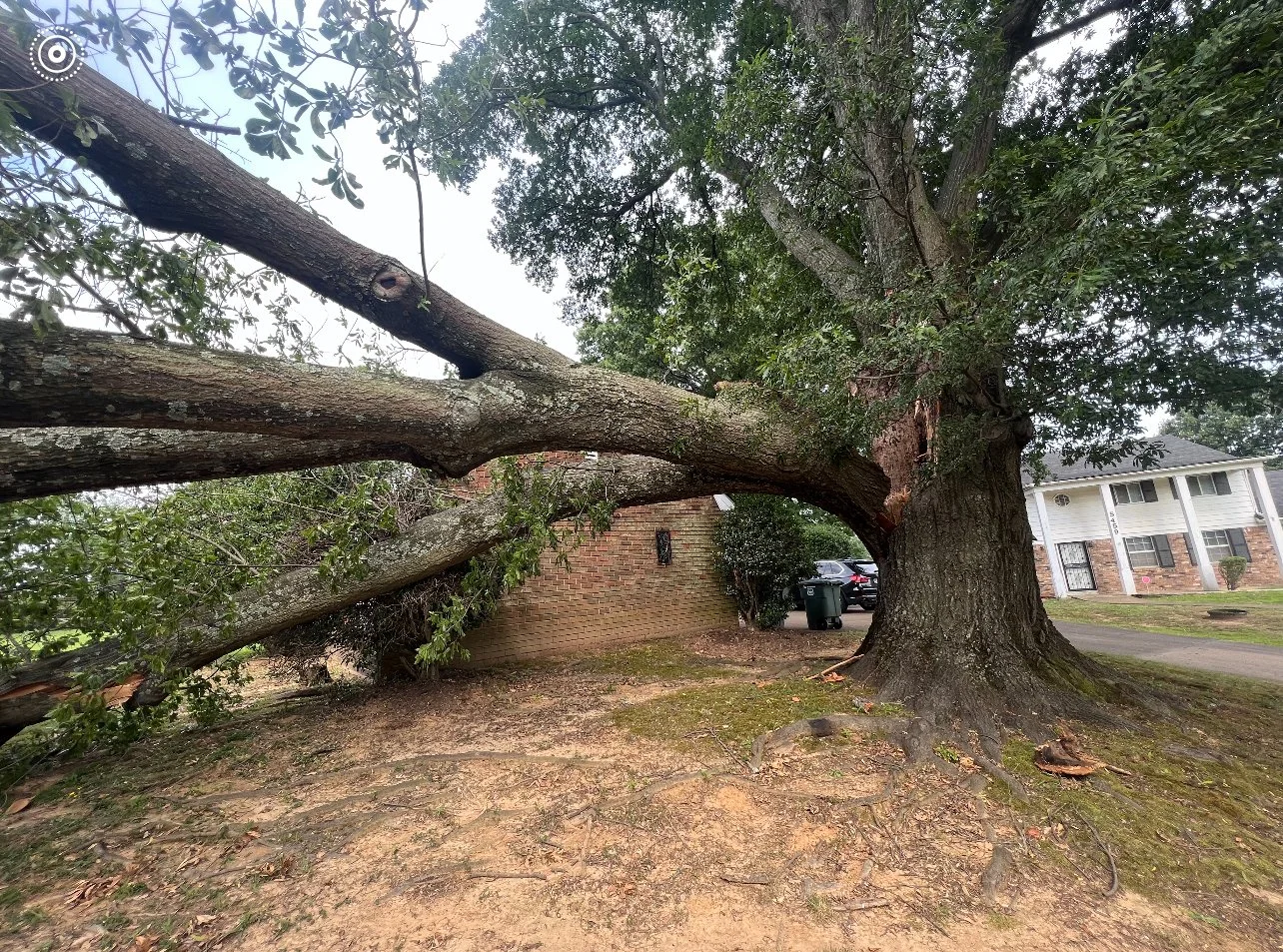
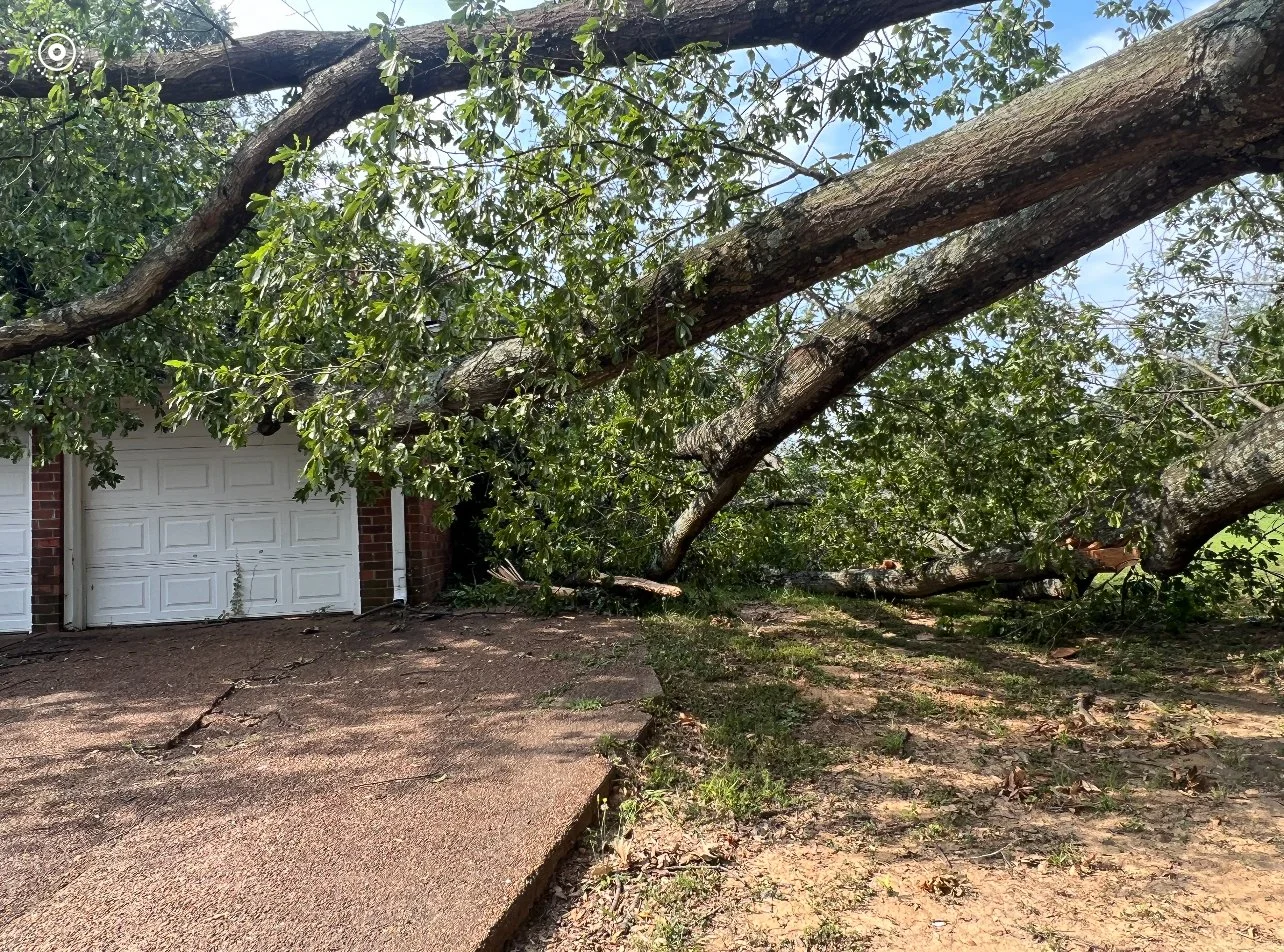
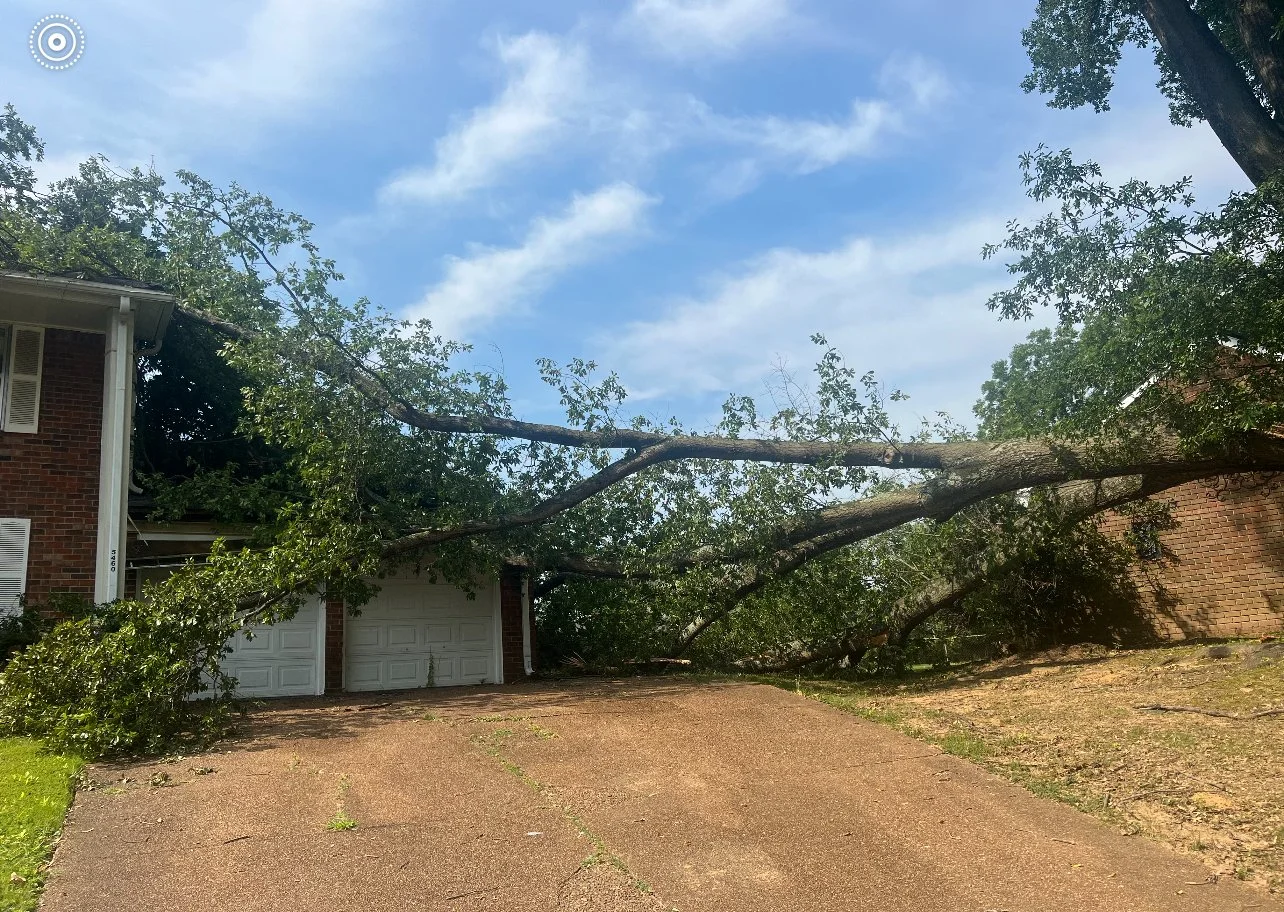
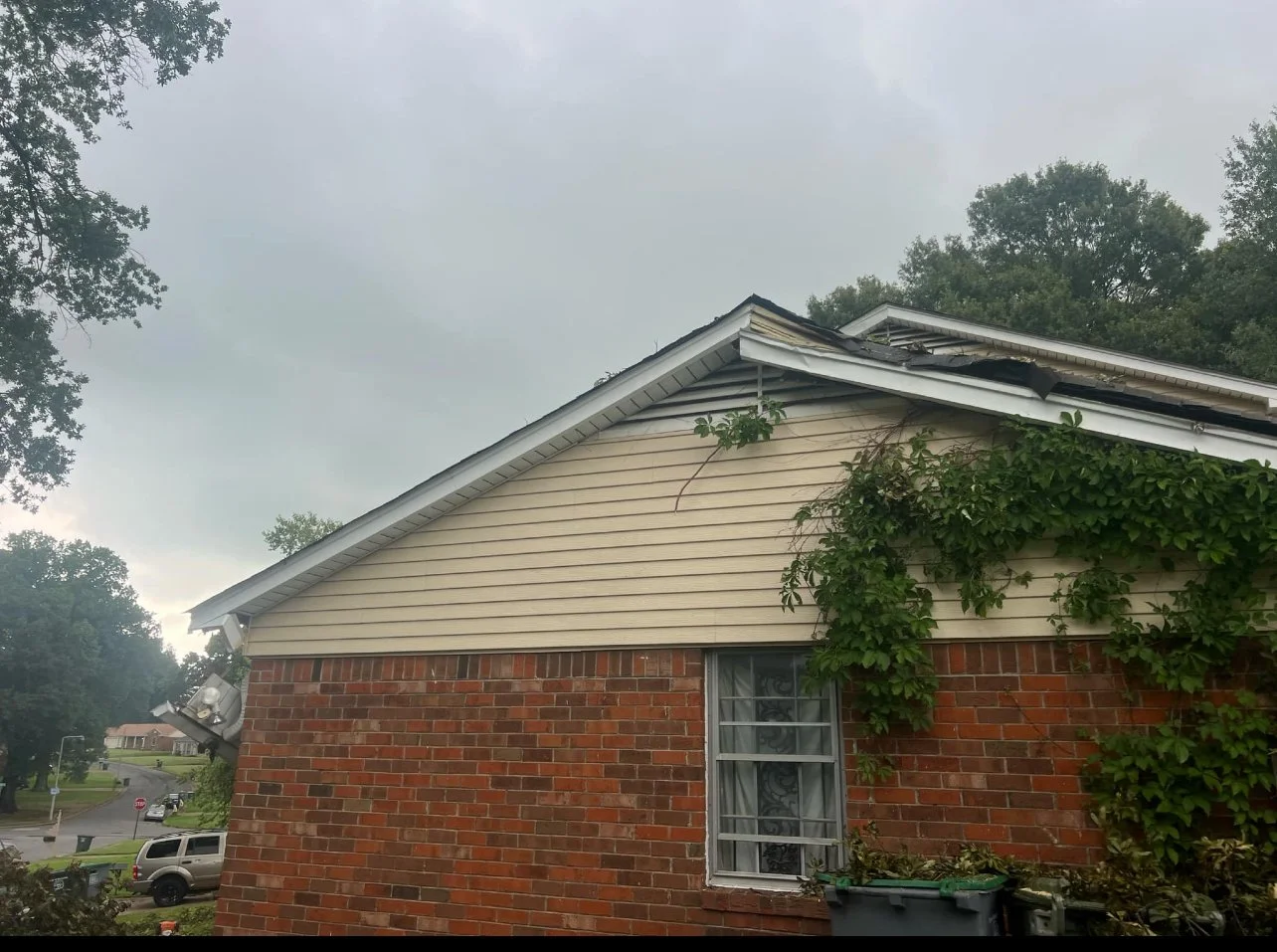


On the day the incident was reported by the tenant, my PM helped me by initiating the claim with my insurance provider. This was possible because I used my PM’s group insurance policy, as discussed earlier.
On August 2nd, we received the estimate to repair the house. While there was no interior damage to the home, the exterior and roof damage was significant, requiring large sections to be repaired or rebuilt. (There was also damage to the side fence, but this isn’t covered by insurance. I opted to haul away the remaining sections of fence at my own expense — as I discuss in my article on rental property maintenance costs, fences are expensive to maintain so I often choose to defer repairs and/or remove them, rather than fix them.)
The total cost of the repair work was ~$15,000. I approved the work immediately, and it was completed by August 26th. This brings us to an important lesson that a lot of inexperienced investors miss: in most cases, you don’t need to wait for your insurance company to confirm that they’ll pay for damage before proceeding with the repairs. The only exception would be if your insurance specifically requests to review or approve rehab quotes. The work of the insurance adjuster typically happens alongside (and even AFTER) the repair work, along with any dispute or negotiations that are needed. That’s why documentation is so critical.
In this case, the adjuster actually didn’t make it out to the home until after the rehab work was complete. I questioned this, but my PM confirmed that this is how they had been operating for years due to a shortage of adjusters — it frequently took them a long time to get out to the property. So the adjuster relied on his inspection of the home after the work was complete, and the documentation (photos and invoices) we provided for the work that was done.
The the work was completed in late August, I didn’t receive payment from my insurance company until late September. The total cost was $18,000, and my deductible at the time was $5,000, so I was expecting $13,000 in reimbursements — but the first payment was only for $10,000. I then initiated a discussion with the provider, who said they needed more documentation on labor and materials used for the rehab, which my PM was able to provide. After multiple back-and-forths via email and phone, the final payment finally came in mid-November. So it took a long while, but I eventually got all the money I was owed.
And thanks to the insurance payment, my cash flow on this property was only slightly negative for the year, despite a fallen tree that caused over $18,000 in damage.
Conclusion
Insurance is one of the most overlooked — and misunderstood — elements of successful rental property investing. Many landlords rightly focus on acquisition, renovation, operations, and financing, but fail to treat insurance as a key pillar of risk management and wealth preservation.
But the truth is that as your rental portfolio grows, so does your exposure to risk. Insurance isn’t just a safety net; it’s a critical part of your business strategy. It’s well worth it to take the time to:
Educate yourself about the different types of coverage
Shop around for the right provider
Proactively manage claims
Review and update your policies regularly
Of course, you hope you never have to use your insurance. But if you do experience storm damage, burst pipes, or a fire, you’ll be very thankful you had the right insurance in place.
Further reading: here’s another article of mine about the recent upheaval in the insurance industry, and how rental investors can keep their insurance costs down.
About the Author
Hi, I’m Eric! I used cash-flowing rental properties to leave my corporate career at age 39. I started Rental Income Advisors in 2020 to help other people achieve their own goals through real estate investing.
My blog focuses on learning & education for new investors, and I make numerous tools & resources available for free, including my industry-leading Rental Property Analyzer.
I also now serve as a coach to dozens of private clients starting their own journeys investing in rental properties, and have helped my clients buy millions of dollars (and counting) in real estate. To chat with me about coaching, schedule a free initial consultation.
